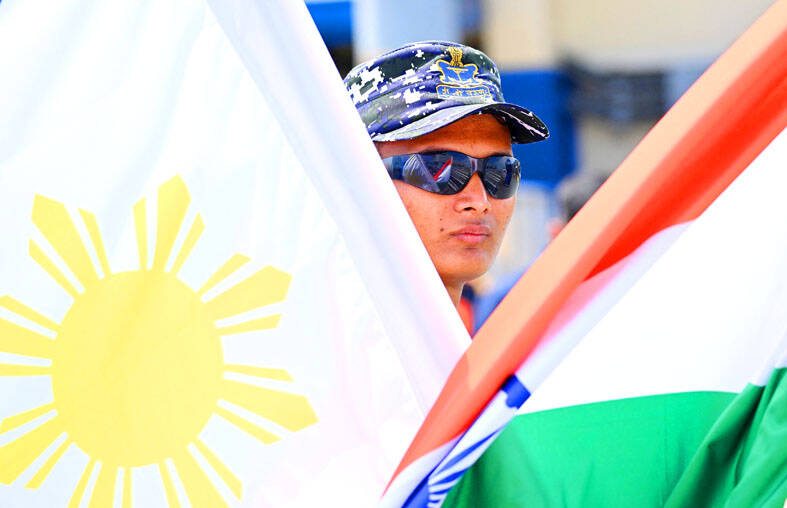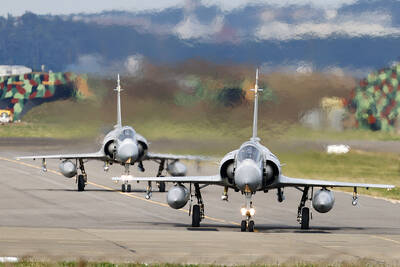India and the Philippines have staged joint naval exercises in the disputed South China Sea for the first time, a high-profile military deployment that antagonized China.
Beijing has separate territorial disputes with the two Asian democracies and a long-running regional rivalry with New Delhi.
Armed Forces of the Philippines Chief of Staff General Romeo Brawner yesterday said that the two-day joint naval sail and exercises which began on Sunday went successfully, and expressed hopes that Filipino forces could engage India’s military in more joint maneuvers.

Photo: AFP
Asked if Chinese forces carried out any action in response, Brawner said without elaborating that “we did not experience any untoward incident, but we were still shadowed. We expected that already.”
Two Chinese navy ships, including a guided-missile destroyer, were spotted about 25 nautical miles (46km) from one of two Philippine navy frigates that participated in the joint sail on Sunday, the Philippine military said.
The Chinese military’s Southern Theater Command said it conducted routine patrols in the South China Sea on Sunday and yesterday, adding that it remains resolute in defending China’s territory, and maritime rights and interests.
The Chinese Ministry of Foreign Affairs said that territorial disputes should be resolved by those directly involved without any third-party intervention.
China has a longstanding land border dispute with India in the Himalayas, which sparked a month-long war in 1962 and a number of deadly firefights since.
Separately, Beijing’s expansive claims to virtually the entire South China Sea, a key global trade route, have led to tense confrontations with other claimants, particularly the Philippines and Vietnam. Taiwan, Malaysia and Brunei also lay claim to parts of the contested waters.
The Philippines has staged naval patrols in the disputed waters with its treaty ally, the US, and other strategic partners, including Japan, Australia, New Zealand and France, to promote freedom of navigation and overflight, and strengthen deterrence against China.
It has allowed journalists to join territorial sea and aerial patrols to witness China’s aggressive actions, provoking angry Chinese reactions.
In response to a question last week about Manila’s plans to build up military cooperation, the Chinese Ministry of National Defense called the Philippines a “troublemaker” that has aligned itself with foreign forces to stir up trouble in what China deems its own territorial waters.
Brawner said the Philippines has to boost deterrence to prevent war.
“The way to do that is, No. 1, the Armed Forces of the Philippines has to be strengthened through modernization, and secondly, we need to partner with like-minded nations and that’s what we’re doing with India,” he said last week.
Philippine President Ferdinand Marcos Jr yesterday left for a five-day state visit to India for talks with Indian Prime Minister Narendra Modi and other officials to boost defense, trade and investment, agriculture, tourism and pharmaceutical industry engagements.

Taiwan is gearing up to celebrate the New Year at events across the country, headlined by the annual countdown and Taipei 101 fireworks display at midnight. Many of the events are to be livesteamed online. See below for lineups and links: Taipei Taipei’s New Year’s Party 2026 is to begin at 7pm and run until 1am, with the theme “Sailing to the Future.” South Korean girl group KARA is headlining the concert at Taipei City Hall Plaza, with additional performances by Amber An (安心亞), Nick Chou (周湯豪), hip-hop trio Nine One One (玖壹壹), Bii (畢書盡), girl group Genblue (幻藍小熊) and more. The festivities are to

Auckland rang in 2026 with a downtown fireworks display launched from New Zealand’s tallest structure, Sky Tower, making it the first major city to greet the new year at a celebration dampened by rain, while crowds in Taipei braved the elements to watch Taipei 101’s display. South Pacific countries are the first to bid farewell to 2025. Clocks struck midnight in Auckland, with a population of 1.7 million, 18 hours before the famous ball was to drop in New York’s Times Square. The five-minute display involved 3,500 fireworks launched from the 240m Sky Tower. Smaller community events were canceled across New Zealand’s

‘IRRESPONSIBLE’: Beijing’s constant disruption of the ‘status quo’ in the Taiwan Strait has damaged peace, stability and security in the Indo-Pacific region, MOFA said The Presidential Office yesterday condemned China’s launch of another military drill around Taiwan, saying such actions are a “unilateral provocation” that destabilizes regional peace and stability. China should immediately stop the irresponsible and provocative actions, Presidential Office spokeswoman Karen Kuo (郭雅慧) said, after the Chinese People’s Liberation Army (PLA) yesterday announced the start of a new round of joint exercises around Taiwan by the army, navy and air force, which it said were approaching “from different directions.” Code-named “Justice Mission 2025,” the exercises would be conducted in the Taiwan Strait and in areas north, southwest, southeast and east of Taiwan

UNDER WAY: The contract for advanced sensor systems would be fulfilled in Florida, and is expected to be completed by June 2031, the Pentagon said Lockheed Martin has been given a contract involving foreign military sales to Taiwan to meet what Washington calls “an urgent operational need” of Taiwan’s air force, the Pentagon said on Wednesday. The contract has a ceiling value of US$328.5 million, with US$157.3 million in foreign military sales funds obligated at the time of award, the Pentagon said in a statement. “This contract provides for the procurement and delivery of 55 Infrared Search and Track Legion Enhanced Sensor Pods, processors, pod containers and processor containers required to meet the urgent operational need of the Taiwan air force,” it said. The contract’s work would be